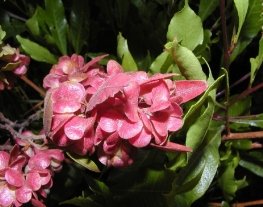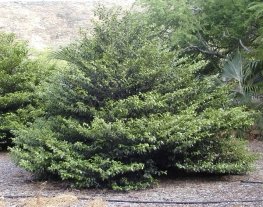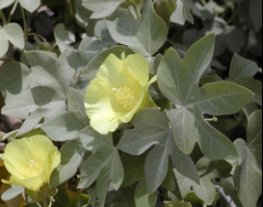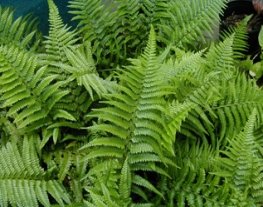Plant species
ʻAʻaliʻi | Dodonaea viscosa
Distribution: ʻAʻaliʻi is an indigenous plant with a range that starts in the dry coastal lowland areas where it was once the most dominant shrub and up into the wetter mesic forests, on all the main islands except for Kahoʻolawe (where it most likely occurred in the past and presently it is being out planted there), and then dominant again in the upper dry forest and sub-alpine dry forests of Maui and Hawaiʻi.
Cultural Uses: The seed capsules are highly valued for used in lei weaving, and the red capsules are used for making a red dye. The beautiful wood of ʻaʻaliʻi is very hard and is used for making smaller hand tools and weapons.
Landscape Uses and Care: This plant does best in full sun with well drained soil and minimal watering. Once planted and there are signs of new growth water can be cut back to once or twice every week. Looks great as an accent plant around large boulders, as specimen plants or even as a hedge, it is also very wind and drought resistant. We use this plant quite often in our restoration work especially on slopes and stream banks, the ʻaʻaliʻi have pretty deep tap roots that act like structural pillars for slope support plus they’re tough plants that need practically no care once in the ground.
Additional Info: In Hawaiʻi there are tons of varieties of this plant but all are classified as the same indigenous species, yet on every island, in every climate zone or elevation zone the plants will look different in some slight way from each other. It is definitely clear that more work needs to be done on the classification of this species. Other names for this plant include: ʻaʻaliʻi ku makani, ʻaʻaliʻi ku ma kua or kumakani.
Ālaheʻe | Psydrax odoratum
Distribution: This indigenous tree is found in the dry to mesic forests on all islands except Niʻihau and Kahoʻolawe. In certain places you can still find this plant along the coast.
Cultural Uses: Digging tools and adze handles were made from the hard wood of this plant while a black dye was made from the leaves. The flowers and fruit are also used in lei.
Landscape Uses and Care: Alaheʻe loves full sun and/or partial shade and requires minimal watering once the plant is established in the ground. Looks great as a single specimen plant or even used as a hedge.
Additional Info: The name alaheʻe means slippery/wandering fragrance. It gets this name because when in full bloom, the plant is completely covered in flower clusters and many times you’ll smell the plant before you actually see it.
Maʻo | Gossypium tomentosum
Distribution: This is an increasingly rare plant now listed as threatened but still found in limited populations on all of the main islands except Hawaiʻi in dry, rocky coastal sites up to about 300 ft. in elevation.
Cultural Uses: Maʻo can be strung into lei but primarily this plant was used to make a green dye, hence the name maʻo (green), but it was made from the yellow flowers.
Landscape Uses and Care: This is the perfect plant for the xeric gardener or for anybody interested in a brown-thumb friendly plant. It is basic to take care of and requires practically no water once established. It makes a nice low, dense border plant, not hedge, it looks better if left to look natural and not hedge shaped. If you do have to cut it back, use a pair of clippers and remove only the areas you need to. The more sun and less water you give it the more silvery the foliage will become. Look out for aphids and white flies but both are easy to take care of with store bought pesticides. Plants that are grown slower, with less watering that build up a more silvery sheen will be a little less vulnerable to pests.
Additional Info: This plant helped save the American cotton industry when it was hybridized with the commercial cotton to prevent further destruction caused from the caterpillar of a butterfly which fed on the nectar of the plant. The Hawaiian cotton lacks the flavor lactones within the nectar which would otherwise attract the butterfly to the commercial cotton, but it was the butterfly’s caterpillar that would inflict the damage on the cotton plant. Now without the good nectar, the butterflies don’t show up.
Naʻu | Gardenia brighamii
Distribution: This extremely rare plant is one of many Native Hawaiian plants found on the federal endangered species list. In the wild there is only one plant remaining on Oʻahu and a handful on Lānaʻi, all totaling around 10 plants left in the world. In fact the plants in this pot are the grandchildren of the last remaining plant from Oʻahu. They were once believed to have existed on all of the main islands in the dry forest.
Cultural Uses: The yellow-orange pulp found within the seed capsule was highly valued for making a rich yellow dye for aliʻi. The color is so unique that it was called naʻu, after the plant from which it is derived. The light colored wood was also used for making house posts for people of high status and the fragrant flowers are also strung into beautiful lei. Nowadays this would be the perfect flower for ‘behind da eeah’ (behind the ear) to make the beautiful women of Hawaiʻi even more beautiful, at least they’ll smell better! Nah, only joke!
Landscape Use and Care: This must-have plant looks great as a hedge or as a specimen plant that stands alone in all its glory. Treat this plant like how many people treat their puakenikeni, they put it where everyone can see it! No be shame! Show this plant off, it deserves it. Full sun is best; it will grow faster, stay bushier and flower most although I’ve seen it grow quite well in partial shade. Daily watering is fine if you have well drained soil; if not then wait until the surrounding soil dries out before watering again. Once the plant is established, reduce watering to only when needed, this plant doesn’t require much water which is great for times like now when water conservation is so important.
Koaiʻa | Acacia koaiʻa
Distribution: Much less abundant than koa. Only found on Maui, Molokai, Kauaʻi, Lānaʻi, and Hawaiʻi Island in very restricted populations. There is also a single plant thought to still exist on Oʻahu. Often found in more dry open areas.
Cultural Uses: The very hard wood of this small tree is used to make many useful tools including kapa anvils and spears. The name koaiʻa comes from combining the two words: koa (like the koa tree) and iʻa (fish), since the wood from this plant was used to make fish hooks but more specifically due to its durability, shark hooks.
Landscape Uses and Care: Use as a specimen tree anywhere with lots of sun. Requires little watering and is a beautiful small tree. Because of where it is found naturally, many people prefer to use this tree, rather than koa, in drier low elevation areas. Due to its durability, beauty, cultural significance and size, koaiʻa has the potential to be a very successful landscape tree. Only its rarity is preventing it from being as popular as it should be. Hopefully as more people become native plant enthusiasts, that downfall will change.
Additional Info: Another name for koaiʻa is koai’e. This may be due to the fact that this plant was used to make kapa beaters which are called iʻe kuku. So it’s the type of koa used to make iʻe, hence the name Koaiʻe.
Kokiʻo keʻokeʻo | Hibiscus arnottianus subsp. immaculatus
Distribution: This rare subspecies of native white hibiscus is endemic to the wetter forests in the northern and northwestern valleys of Kauai and nowhere else in the world.
Cultural Uses: The flowers can be eaten as a laxative. Some say that the native red hibiscus was eaten by girls and women, while the white was eaten by boys and men.
Landscape Uses and Care: As with most hibiscuses, the koki’o ke’oke’o can be trimmed into a beautiful and colorful hedge, but I think it looks better as a stand-alone plant to be admired from all directions.
It can handle full sun quite well but does best in partially shaded areas with filtered sunlight. Hint: Plant it in front of a dark background — such as a rock wall or ti hedge — to really show off the flowers!
Watch out for aphids and whiteflies. Either shoot them off with a water hose or spray them with pesticide. You should have good results if you follow the directions on the bottle.
Additional Information: The native white hibiscuses, which include Hibiscus arnottianus (found on Oʻahu and Molokaʻi) and this species, H. waimeae, are the only naturally fragrant hibiscuses in the world. Of the ones listed above, this flower is the most fragrant, making it—the most naturally fragrant hibiscus in the WORLD! Sweet! An endangered subspecies of this plant H. waimeae subsp. hannerae is also found on Kauaʻi and has a much smaller flower but is still quite fragrant.
Palapalai | Microlepia strigosa
Distribution: Palapalai is an indigenous fern meaning that it is native to Hawaiʻi but also other places. Here it is found on all the main islands, in usually mesic forests but occasionally in dry or even wet forests as well, from near sea level all the way up to about 5000 ft. elevation.
Cultural Uses: Palapalai is a very important plant in Hawaiian culture, primarily for hula. It is one of the plants kapu (sacred) to Laka, the goddess of hula, it is also used to adorn the hula altar and dancer as well and is highly sought after for making lei. Many songs and chants also refer to palapalai for its beauty and cultural importance.
Landscape Uses: For years, palapalai has been sold in stores and used in landscapes here in Hawaiʻi and throughout the world. Although, chances are these are not the ones native to Hawaiʻi, they most likely came from Asia where they are also native. Even the ferns that are normally sold here as “palapalai” are propagated either in the mainland or sometimes Mexico then shipped to nurseries in Hawaiʻi. So, once you get the Hawaiian variety, you can plant them in any semi-shaded area like under the eve of your house, at the base of a larger tree, or even kept in a bright room with daily misting. Daily watering is ok once planted in the ground and routine application of compost, mulch or fertilizer will keep it looking full and green. Keep it in a more protected area since they can be prone to wind damage.
Species information and photos adapted from Hui Kū Maoli Ola







